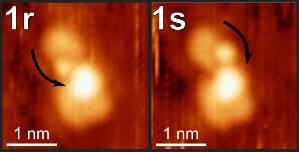题目:Single Catalytic Site Studies of Selective Chemistry on Metals and Metal Carbides
报告人:Prof. Peter McBreen (Department of Chemistry, Laval University, Québec City, Canada)
时间:12月15日(周四)9:30-11:00
地点:李薰楼468会议室
Single Catalytic Site Studies of Selective Chemistry on Metals and Metal Carbides
Peter McBreen
Department of Chemistry, Laval University, Québec City, Canada
This talk will first describe experimental surface studies of individual bimolecular complexes formed between chiral and prochiral molecules on Pt(111). The work is inspired by the catalysis literature on the enantioselective hydrogenation of ketones and ketoesters on chirally-modified Pt catalysts. Using scanning tunneling microscopy (STM) supported by density functional theory (DFT), we probe non-covalently bonded chemisorption complexes formed between representative prochiral substrates and a chiral molecule, (R)-NEA. In all of the systems studied, multiple complexation configurations are populated around the chiral center. Comparison to DFT-predicted structures is used to determine the hierarchy of chemisorption and, sometimes multiple, H-bonding interactions operating in complexes. Sub-molecularly resolved STM images permit the determination of the prochiral ratio (pr) proper to specific locations around the stereogenic center, and the overall pr can, in some cases, be compared to literature values for the enantiomeric ratio (er) for hydrogenation using the same modifier/substrate pair. Time-lapsed STM measurements are used to explore the fluxional properties of individual complexes (Fig. 1). The STM experiments provide access to the preorganization step required for the emergence of enantioselectivity and the DFT calculations suggest future approaches to gaining kinetic information on state-specific hydrogenation.

Figure 1. Consecutive STM images of an individual prochiral molecule/(R)-NEA complex taken at a frame rate of one per 52.6 s. The prochirality of TFAP, pro-R or pro-S, is indicated by r or s, respectively.
Further approaches for tuning selectivity in catalytic reactions at surfaces will be described using surface spectroscopy data for deoxygenation and olefin-metathesis reactions on bulk Mo2C. Selective deoxygenation of carbonyl groups on Mo2C leads to the formation of isolated akylidene groups and these are, in turn, active olefin metathesis initiating sites.
Prof. Peter McBreen received a doctorate in Physical Chemistry in 1981 under the direction of Prof. Martin Moskovits at the University of Toronto. His PhD project was on the study of plasmonic and chemisorption properties of nanostructured metal films. He did postdoctoral work on Fischer-Tropsch chemistry as a Junior Alexander von Humboldt Fellow with Prof. Harald Ibach at the Surface Science Institute (IGF-KFA) in Jülich, Germany. Prior to moving to Université Laval, he worked as a Research Associate with Prof. Micha Polak on hydrogen-storage intermetallic alloys in the Department of Materials Engineering at Ben-Gurion University of the Negev, Israel. Dr. McBreen’s research activities at University Laval are in the area of chemical reactivity at surfaces. His group uses surface science techniques to study single molecule events in areas such as chirality transfer and surface olefin metathesis. McBreen is the recipient of the 2006 Canadian Catalysis Lectureship Tour Award and is a Fellow of the American Academy for the Advancement of Science.



